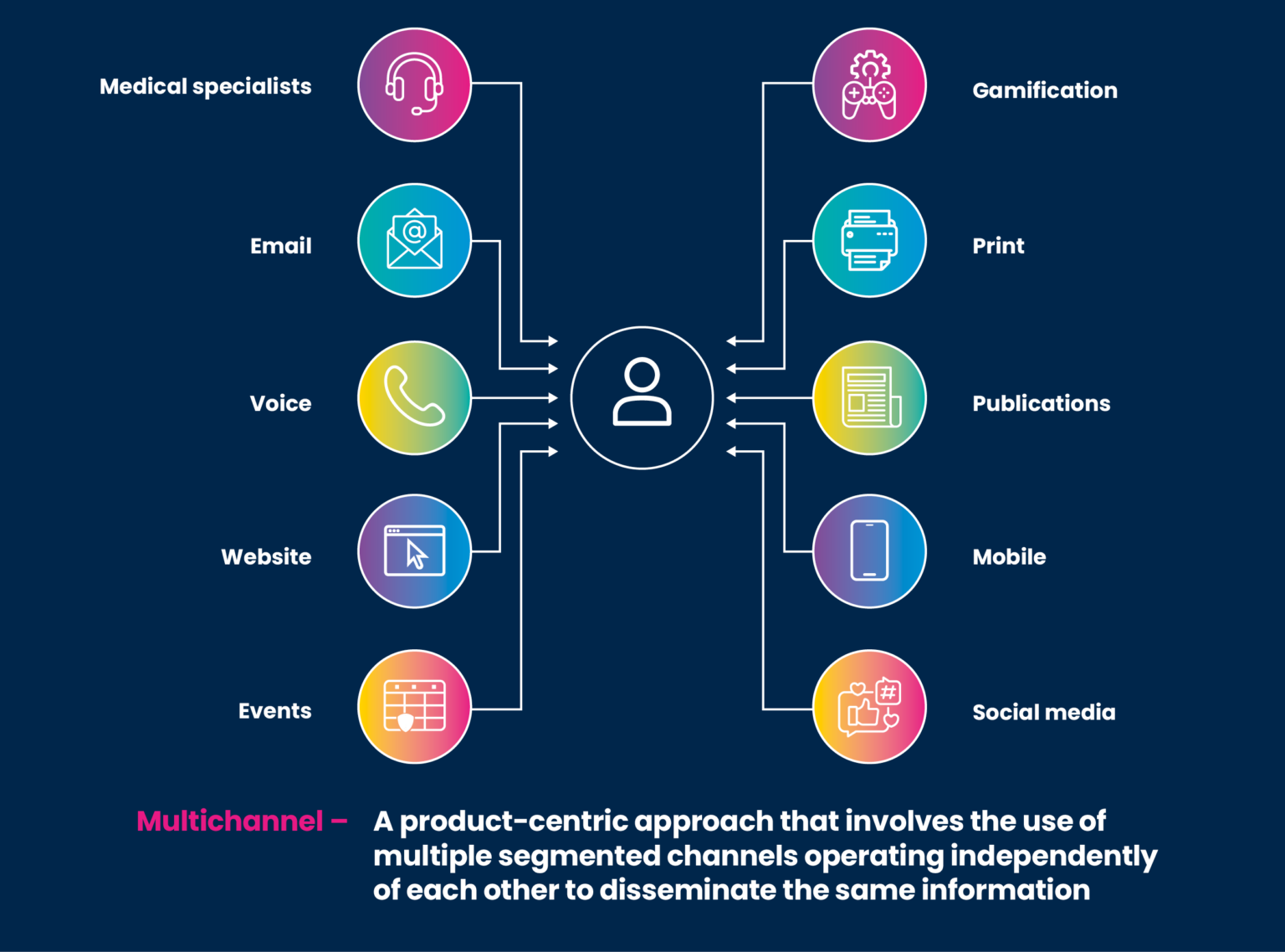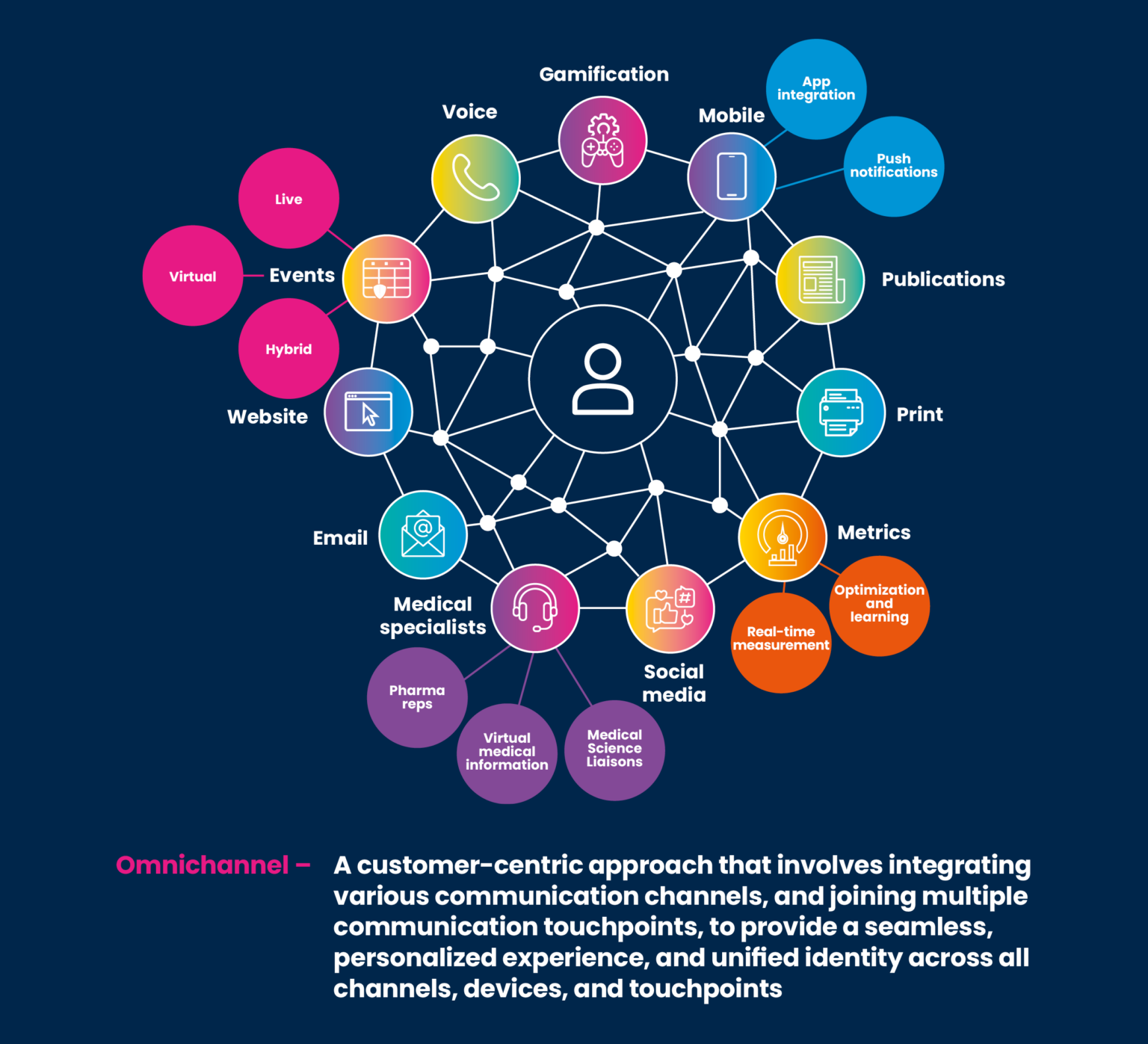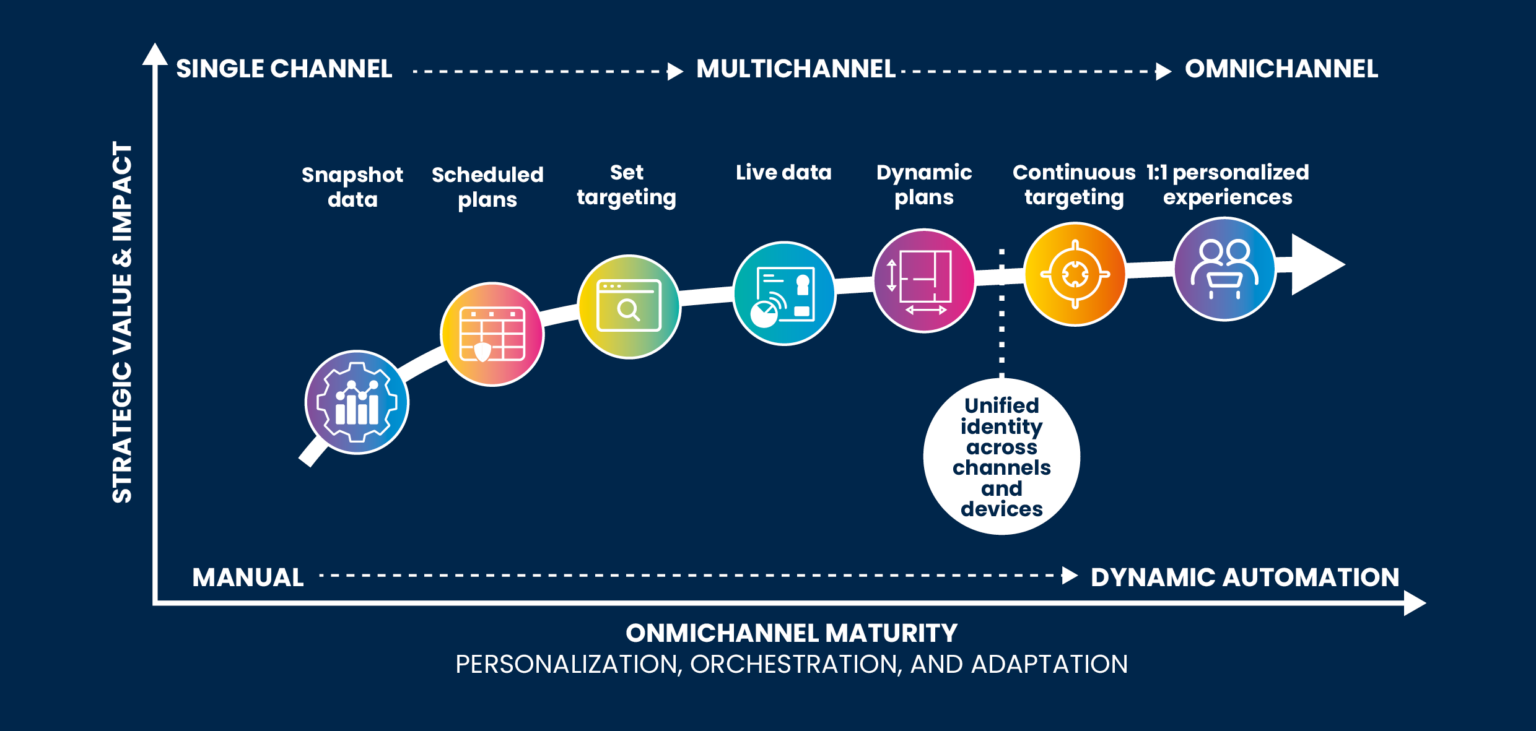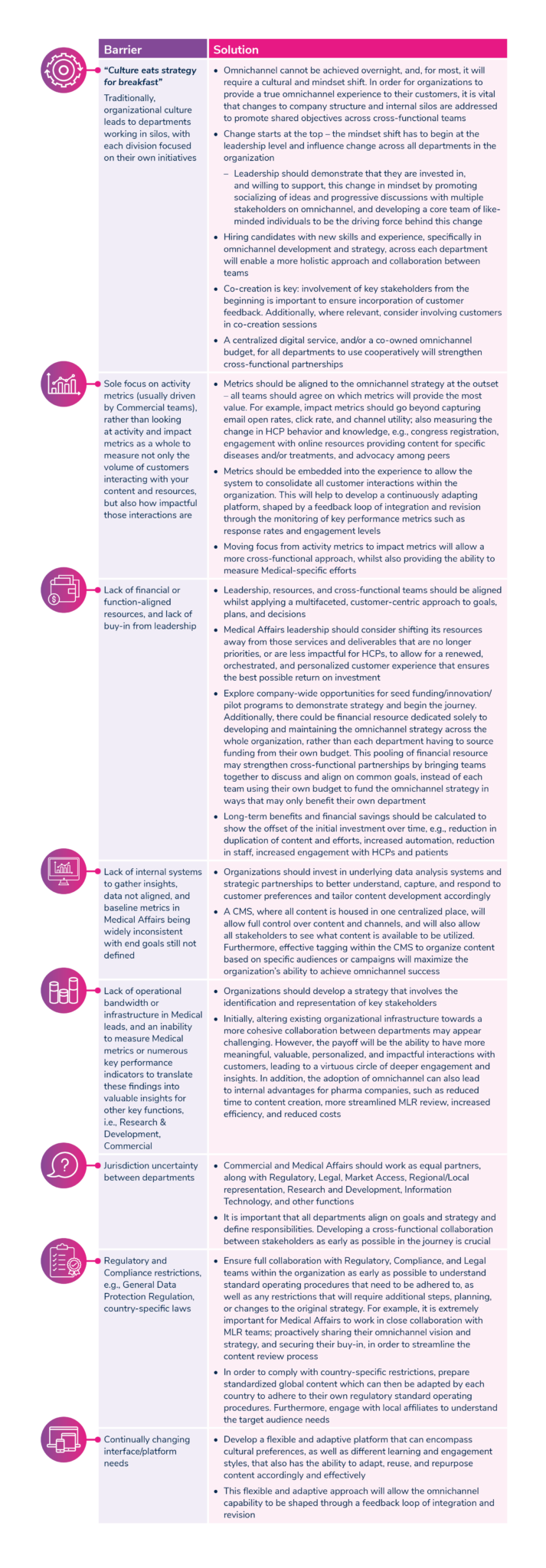Omnichannel integration in Medical Affairs: from aspiration to reality
- Anna-Lisa Fisher, Pillar Lead, Medical Communications, Boehringer Ingelheim
- Kimberly Friedrichs, Channel Experience Strategy Lead, F. Hoffmann-La Roche
- Niki A. Georgiou, Innovation Lead, Global Medical Affairs, Boehringer Ingelheim International GmbH
- Miguel Angel de Blas Martin, Global Director, Scientific Communications, Novartis
- Arron Mungul, Co-Lead Focus Area Working Group (Medical Strategy + Launch Excellence) and Strategy Domain Lead, Medical Affairs Professional Society; Founder, Apogee Life Sciences
- Shehla Sheikh, Head of Medical Communication & Publications, Kyowa Kirin
- JT Tibung, Senior Medical Director, Global Medical Neurology, Alexion, AstraZeneca Rare Disease
- Marleen van der Voort, Executive Director, Scientific Communications & Content, Astellas Pharma Europe Ltd
- Kendal McCulloch, Associate Medical Director, IPG Health Medical Communications
- Derek Lavery, SVP, Senior Medical Strategy Director, IPG Health Medical Communications
- Charlotte Moseley, Executive Director, Client Engagement, IPG Health Medical Communications
Disclaimer: This article has been created with input from a cross-industry group. The opinions and views expressed within this article are solely based on the authors’ experience and do not represent the explicit views of the companies that they currently work for, or have worked for previously. This article is the output of a roundtable meeting that took place at MAPS EMEA 2023, and discussions thereafter. No payments to authors were made in relation to this article.
Healthcare delivery is continuously evolving to fit the needs and expectations of healthcare professionals (HCPs) and patients. This evolution is fueled by the aging population, increased financial burden, and identification of more complex conditions and treatments. The increasing popularity of digital health, the expectation for real-time outcomes, and digital tools becoming more readily accessible also play a role. Through omnichannel integration, Medical Affairs, in collaboration with other functions, is in prime position to enable pharma companies to bridge the gap between aspiration and reality in delivering a seamless, personalized, and unified customer experience. However, where do we start?
A group of Medical Affairs experts convened to discuss the omnichannel opportunity and the implications for pharma companies. In the following article, we outline our thoughts, considerations, and actions that we feel are important to take as individuals and teams to realize this aspiration of omnichannel integration in Medical Affairs.
Understanding multichannel vs omnichannel communication
Multichannel communication takes a product-centric approach and involves the use of multiple segmented channels that operate independently of each other to disseminate information, inevitably leading to data silos. It involves one overarching campaign adapted across multiple channels that are not necessarily integrated – this demands significant time, costs, and efforts in order to effectively develop and distribute multiple resources across all channels, continually manage each of the channels and associated platforms, and, because channels are not connected, there is an additional need to separately monitor/analyze metrics for each individual channel.
Furthermore, in a multichannel setting, internal coordination is often lacking. Teams frequently operate independently, with limited awareness of the information and resources developed and presented by other functions; this separation also extends to Global and Regional approaches. There is an unavoidable ‘push’ nature with multichannel communication as it often focuses on short-term results and lacks a consistent, targeted, and unified customer journey experience, eventually leading to customer disengagement. Additionally, multichannel tends to employ quantitative metrics to measure success. This approach focuses on activity metrics, e.g., email open rates, page visits, and click rate, rather than utilizing qualitative metrics which can measure impact, demonstrate the value and effectiveness of the omnichannel strategy execution, and provide invaluable insights into changes in customer needs and behaviors.

Omnichannel communication is the strategy of integrating various communication channels, both digital and non-digital, and joining multiple communication touchpoints to provide a seamless, personalized experience, and unified identity across all channels, devices, and touchpoints: the customer (namely HCPs and patients), rather than the product, is at the center. Omnichannel focuses on delivering a consistent, connected, and personalized experience whilst fulfilling the educational needs of HCPs, as well as patients, to become more informed on disease states and therapeutic options. This is achieved by the integration of real-time data to ensure that each function has a full 360° view of the customer and their interactions with the company, leading to a personalized experience that has impact and brings value for each individual customer. For example, the omnichannel journey will provide patients with different experiences, as well as access to different types of content, compared with HCPs. Already common in retail, a true omnichannel experience ensures that no matter what device you use, or whether you shop in-store, you are provided with a completely seamless and personalized experience – from content suggestions based on your search history and previously bought items, to discount emails applicable to products sitting in your cart or saved-for-later list. To achieve this level of individual personalization, underlying real-time data collection that provides an all-encompassing view of the customer, feedback mechanisms allowing for iterations, and algorithms are pivotal. Data that can be visualized in an actionable way to allow all departments to gain insight into customer behavior and implement the necessary changes are also important.
Due to changes in healthcare delivery, as well as the continuously evolving needs and expectations of HCPs and patients, there is a strong focus on the need to move to an omnichannel strategy of communication. An omnichannel approach can transform the way pharma companies engage with their customers and key stakeholders, resulting in more meaningful, valuable, personalized, and impactful interactions, and leading to a virtuous circle of deeper engagement and insight. Although the initial buy-in, development, and implementation of an omnichannel strategy may be cost-heavy and require a lot of input and resources at the beginning of the journey, over time the adoption of omnichannel can lead to many long-term benefits for pharma companies. For example, reduction in duplication of content and efforts, reduction in time to content creation, increased automation, increased efficiencies (e.g., more streamlined Medical, Legal, and Regulatory [MLR] review), and most importantly, increased engagement with HCPs and patients. Implementing an effective omnichannel strategy will overcome internal barriers, such as a lack of coordination and cohesiveness between functions. An omnichannel setting fosters the development of internal partnerships and, in turn, leads to increased efficiencies. Furthermore, the adoption of an integrated omnichannel strategy benefits HCPs by providing relevant, tailored information and support at relevant timepoints, which ultimately improves patient health outcomes.

The vision is for a practical and simple solution that can evolve as technology evolves, but…
- What steps are needed to bridge the gap between aspiration and reality, and integrate omnichannel in Medical Affairs?
- How do we develop a single, seamless, and integrated interface that provides access to content via a unified and consistent learning journey, whilst also providing tailored content that continually develops alongside the current trends of HCPs?
- How do we create and implement an effective and efficient feedback loop that is iterative and adaptive to HCP insights and behaviors?
Key questions for you and your colleagues to consider throughout this article:
- Where do you, your team, and your organization currently sit on the omnichannel maturity curve?
- What is your strategy for transitioning from single/multichannel engagement to a holistic HCP omnichannel experience?
- What are the main barriers preventing this transition?
- Which metric(s) of success do you currently employ to measure the impact, value, and effectiveness of your organization’s omnichannel strategy?
- What resources/organizational changes do you need to make your omnichannel aspiration a reality?

Steps to achieving omnichannel success
-
Co-create a unified strategy for the customer omnichannel journey
Aim: Provide a consistent and unified learning experience across all aspects of the organization that best supports the customer.
“A close-knit collaboration across the different functions within Medical Affairs and between cross-functional counterparts, including Commercial and Market Access, that is geared towards addressing individual customers’ needs”
Actions to achieve omnichannel success:
- Develop a strong core strategy centered on the needs of the customer. Key questions to consider: What is the need for implementing an omnichannel strategy? What do HCPs and patients need regarding medical information, education, and product knowledge, and how can the omnichannel journey be developed to put this at the forefront? Through which channels does each individual HCP and patient prefer to receive information? What is the strategy needed to establish a platform that can adjust accordingly and automatically to ensure that HCPs, the product(s), and ultimately patient outcomes are best supported? Is an omnichannel strategy required for every brand/product?
- It is important to build company-wide omnichannel capabilities to remove traditional functional, divisional, or departmental barriers and provide a truly holistic, integrated, future- and customer-focused approach. This will allow the organization, as a whole, to maximize the value for customers.
- Develop a cross-functional team that includes collaboration from all stakeholders as early as possible in the journey, gaining valuable insights into the current trends of HCPs and the therapy area. Learning as a collaborative group takes time before full integration is possible. Therefore, to build and sustain a truly cross-functional and collaborative team across the organization, parameters should be established at the outset to ensure that the right people from the relevant teams are included at the most effective time. Additionally, impact metrics that demonstrate the value of the omnichannel strategy execution should be put in place with the customers’ needs at the forefront.
- Whilst the end goals may differ for each department/function, the overall objective of providing a unified customer experience remains the same. The approach to integrating departments and developing a cross-functional team will be unique to each individual organization and depend on their omnichannel strategy. However, most, if not all, will rely on Commercial, Medical Affairs, Regulatory, Legal, Market Access, Regional/Local representation, Research and Development, Clinical Development, Information Technology, and other functions working as equal partners early in the solution and collaborating throughout all aspects of the process. All departments will play integral roles, with each function bringing a unique perspective and skillset to the omnichannel journey.
- Responsibilities should be clearly defined, and the value of Medical and role of Medical Science Liaisons (MSLs) to integrate with Commercial perspectives should be leveraged. Accountabilities might shift based on the product lifecycle and the patient journey.
- Whilst Commercial can provide product information and patient programs, a unique strength of Medical Affairs and MSLs is the ability to collaborate across multiple departments and bridge the gap between various functions, and more importantly, the ability to engage with HCPs and patients regarding their needs; providing medical information and education, as well as addressing HCPs’ knowledge gaps. Additionally, the involvement of Medical Affairs as leaders in omnichannel planning is pivotal for ensuring medical accuracy is maintained, compliance considerations are adhered to, and impactful communication strategies are implemented, whilst also aligning with broader organizational goals. This will ultimately lead to better and more trusted engagement with HCPs and patients, and, in turn, increased responsiveness and a more positive perception of the organization.
- Transforming content creation and re-use of existing materials will be key – the volume of content will increase substantially due to the personalization for individual customers, as well as creating content in various formats to fit each of the channels.
- For example, a modular approach will greatly enhance the ability to create relevant materials quickly and at a large scale – developing modular content with pre-approved content modules, rather than always creating content from scratch, will allow assets to be easily and efficiently updated or altered in a much shorter timeframe. Additionally, modular content can be tagged to track each content module, measuring the impact and value for each individual customer. There is also increasing interest from the pharma industry to explore utilizing generative AI for content creation.
- Furthermore, to mitigate delayed content turnaround times due to time-consuming internal review, it is important for the teams responsible for content development to work in close collaboration with MLR teams, with this critical team becoming more proactive and involved in the process at an earlier stage. Consider sharing the omnichannel strategy with review teams and factoring in concept review meetings with MLR ahead of content creation.
Omnichannel is not a different department, it describes how a company engages with its customers and brings all departments together
-
Generate a single, integrated omnichannel interface
Aim: Develop a single, seamless, and integrated interface, or adapt and utilize an existing in-house system, that provides a unified and consistent learning experience for the customer, with access to medical information, education, and product knowledge that evolves alongside the current trends.
“Customer engagement requires a central strategy, clear guardrails, and joint central foundation systems, including a globally shared CRM, where acceptable, and company-wide customer insights and analytics”
Actions to achieve omnichannel success:
- In order for organizations to provide a true omnichannel experience to their customers, it is vital that changes to company structure are addressed, as well as addressing the mindset shift towards a more omnichannel-focused approach.
- Typically, organizations are used to planning, delivering content, analyzing metrics, and then moving onto the next activity. However, with omnichannel, organizations should be ready to quickly and efficiently adapt content (new and existing) and their engagement styles based on the continuously evolving customer insights gained from metrics embedded in the omnichannel experience.
- Organizations will often work in silos, with each division focused on their own initiatives. Developing a content management system (CMS), where all content is housed in one centralized place, will allow all stakeholders to see what content is available to be utilized, preventing the duplication of content across divisions and countries. This in turn will increase efficiency and reduce costs within the organization.
- Recent data from the 2023 Medical Affairs Metrics Benchmark Survey indicated that only 60% of the 51 respondents tracked insights and outcomes and reported them as metrics, with customer relationship management (CRM; 55%), SharePoint (47%), and Excel spreadsheets (39%) being the most prevalent tracking tools used.1 With 40% of respondents not tracking insights, this highlights a gap in understanding the importance of tracking data and progress against metrics. Therefore, at the beginning of the omnichannel journey, all divisions and teams should agree on the importance of metrics, align on what metrics will provide the most effective insights, and fully integrate these tracking metrics into the omnichannel strategy.
- Functional teams across the organization that have different systems for collecting the relevant information should be connected for application to omnichannel. For example, within an organization, there is a large volume of customer information, and the challenge is to collate this into a single consensus that adheres to data compliance and will inform the unified customer profiles necessary for an integrated customer journey, e.g., connecting data from virtual congresses with MSL visits and publication views.
- To gain a truly holistic 360° view of your customers, all data should be housed in an integrated data lake. This will allow storage, management, and analysis of large volumes of live data, as well as existing data, from various sources in a centralized, governed repository; each department can utilize this integrated data lake to identify evolving customer behaviors, preferences, attitudes, and needs in real time.
- Using CRM tools to track various activities across multiple channels, including Key Opinion Leader interactions, MSL insights, publications, website views, clinical study progress, congress activity and attendance, and changes in HCP behavior, will help provide a more complete picture of the clinical landscape and HCP engagement, with the ability to inform and steer the best next action for the HCP. Additionally, Medical, Commercial, Marketing, and other teams can all make use of this resource in a compliant manner and gain access to the same data, which will promote consistency and unification across the organization.
- Other considerations for integration and functionality include regional and local differences in regulations, approval systems, MLR review, the technology available, team functions, roles, and organization, as well as differing interpretations of needs.
Make it relevant, make it personalized, make it streamlined
-
Develop an omnichannel platform strategy that responds to customers’ needs
Aim: Provide a practical platform strategy that can develop as technology advances, with flexible channels to encompass diverse customer and stakeholder preferences, as well as different learning and engagement styles.
“We aim to make our customer experience as transformative as our science”
Actions to achieve omnichannel success:
- The omnichannel experience should be defined by HCPs and patients, with a firm understanding of the information needs and preferences for access. Additional consideration should be given to setting up a platform in co-creation with customers. Furthermore, the modulation of content to encompass diverse customer and stakeholder preferences and learning styles, and the development of flexible platform channels that have the ability to adapt, reuse, and repurpose content accordingly and effectively, will be essential.
- It is vital that Medical Affairs adapt and evolve alongside the current trends of HCPs to maximize engagement and interaction. For example, Medical teams have been hesitant to explore the social media space; however, HCP engagement is forever evolving, with many individuals and organizations now using platforms such as LinkedIn, Facebook, YouTube, X, Instagram, and TikTok for professional purposes. Over 40% of HCPs consider social media very important for accessing scientific information; >30% of HCPs born after 1990 reported using Facebook, Instagram, and YouTube multiple times per day for scientific information.2 Therefore, developing a social media presence, as well as using traditional channels, such as congresses and MSL engagement, is critical for pharma companies to connect with HCPs on a wider scale. Additionally, service providers reported a significant increase in focus on podcasts, despite these remaining among the channels ranked least important by pharma.2
- Developing a fully functioning CMS will allow full control over content and channels, and effective tagging within the CMS to organize content based on specific audiences or campaigns will maximize the organization’s ability to achieve omnichannel success.
- It is pivotal to invest in underlying data analysis systems to better understand, capture, adapt to, and respond to customer segmentations, preferences, and content generation. Metrics should be aligned with the omnichannel strategy at the outset and embedded in the experience, allowing the system to consolidate all customer interactions within the organization to develop a continuously adapting platform, shaped by a feedback loop of integration and revision through the monitoring of key performance metrics such as response rates and engagement levels. This will provide the ability to handle rapid responses to clinical queries and to evolve those responses based on changing customer needs in regard to learning and clinical decision-making whilst ensuring that responses are consistent, regardless of how the user accesses the omnichannel journey or who responds from within the organization.
- Create multiple connected touchpoints for customers within the omnichannel experience.
Each customer interaction within the omnichannel system can be recorded and added to their customer profile – the more complete a customer profile is, the better the ability to deliver the most relevant messages, at the right time, through the appropriate channel. - There is also the option to invest in third parties, e.g., Medical Communications, MedTech, and specialist consultancy agencies, and utilize their data sources to provide a more holistic picture of HCPs’ behaviors and belief systems, enabling a more customized and impactful communication approach.
Strategic insights, data, and technology combined ensure the right message is delivered to the right person, via the right channel, at the right time
A company-wide mindset shift is required to move from a multichannel status quo to an omnichannel reality. To bridge the gap between aspiration and reality, there should be a willingness to challenge the status quo, develop a strategic approach, create a cohesive organizational culture, and embrace technology and innovation, with the goal being to adequately respond to, and ultimately anticipate, patients’ and HCPs’ needs. Medical Affairs holds a unique position within an organization through the ability to collaborate across multiple functions, and, more importantly, the ability to engage HCPs and patients in discussion about their needs. Providing medical information and education, as well as addressing HCPs’ knowledge gaps, there is the opportunity and ability for Medical Affairs to be at the forefront of omnichannel integration, thus delivering a truly revolutionary way to engage with their customers. In order to do this in a meaningful, valuable, and impactful way, the journey towards omnichannel integration must begin now.
Barriers and solutions to achieving omnichannel success

References
- Medical Affairs Professional Society. 2023 Medical Affairs Metrics Benchmark. Available at: https://medicalaffairs.org/medical-affairs-metrics-benchmarking/. Accessed: 8 November 2023.
- EPG Health. Research Study: The Future of HCP Engagement Impact. 2023. Available at: https://epghealth.com/reports/the-future-of-hcp-engagement-impact/?utm_source=Report_Document&utm_medium=PDF&utm_campaign=2023_Future_Report-Document_links. Accessed 8 November 2023.



